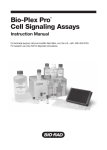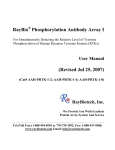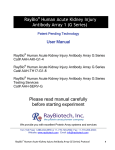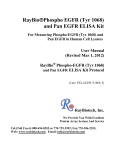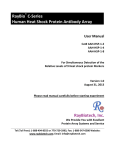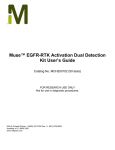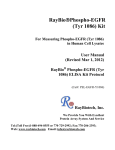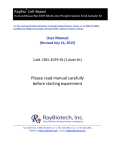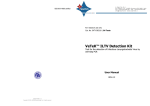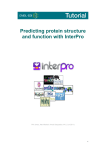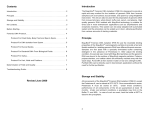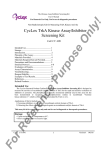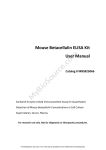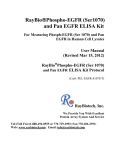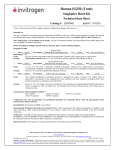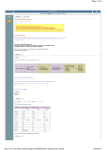Download Please read manual carefully before starting experiment RayBio
Transcript
Li StarFish S.r.l. Via Cavour, 35 - 20063 Cernusco S/N (MI), Italy Tel. +39-02-92150794 - Fax. +39-02-92157285 [email protected] -www.listarfish.it RayBio® Human EGFR Phosphorylation Antibody Array 1 User Manual For Simultaneously Detecting the Relative Levels of Phosphorylation of EGF Receptors at 17 Different Phosphorylation Sites. (Cat# RAY-AAH-PER-1-2; RAY-AAH-PER-1-4; RAY-AAH-PER-1-8) Please read manual carefully before starting experiment We Provide You with Excellent Protein Array Systems and Service RayBio® Human EGFR Phosphorylation Antibody Array 1 Protocol TABLE OF CONTENTS I. Introduction……..……………………………... How It Works………………..………………… II. Materials Provided…………………………….. III. Additional Materials Required………………… IV. Reagent Preparation…………………………… V. Overview and General Considerations………… a. Preparation of Samples……………………… b. Handling Array Membrane…………………. c. Incubation…………………………………… VI. Protocol………………………………………… a. Blocking and Incubation……………………. b. Detection…………………………………… . VII. Interpretation of Results……………………….. VIII.Troubleshooting Guide………………………… IX. Reference List…………………………………. RayBio® Human EGFR Phosphorylation Antibody Array 1 1 2 3 4 5 5 7 6 7 7 8 8 10 11 14 15 I. Introduction The EGFR family of membrane receptors consists of four different proteins called EGFR/ErbB1/HER1, ErbB2/HER2, ErbB3/HER3, and ErbB4/HER4. Under normal physiological conditions, the ErbB receptors play crucial roles in propagating signals regulating cell proliferation, differentiation, motility, and apoptosis. EGF receptor family shows clear differences between individual receptors, and also a large overlap. ErbB1 is the family member with most interaction partners and the highest percentage of tyrosine residues with more than one binding partner. ErbB3 is characterized by a large number of binding sites for phosphatidylinositol-3kinase (PI3K), while ErbB2 has only few interaction partners with Shc as the most frequent one. ErbB1 and ErbB4 have a variety of phosphotyrosines that bind Grb2, or Grb2 and Shc. The ErbB1 and ErbB4 have a greater diversity of interaction partners than ErbB2 and ErbB3. ErbB1 and ErbB2 are often over-expressed or amplified in cancers, making them important targets for drugs currently in use or under development. With the RayBio® Human EGFR Phosphorylation Antibody Array 1, researchers can now simultaneously detect the relative level of phosphorylation of 17 different specific sites for Human EGFR family in cell lysate. By monitoring the changes in protein phosphorylation in your experimental model system, you can verify pathway activation in your cell lines without spending excess time and effort in performing an analysis of immunoprecipitation and/or Western Blot. By using RayBio® Human EGFR Phosphorylation antibody Array 1, treated or untreated cell lysate is added into antibody array membranes. The antibody array membranes are washed and cocktail of biotin-congujated antiEGFR is used to detect phosphorylated EGFR on activated receptors. After incubation with HRP-streptavidin, the signals are visualized by chemiluminescence. RayBio® Human EGFR Phosphorylation Antibody Array 1 2 Here’s how it works + Sample Antibody array chips Incubation of Sample with arrayed antibody chips 2 hrs Cocktail of biotinconjugated anti-EGFR 2 hrs Incubation with cocktail of biotin-conjugated antiEGFR Labeled Streptavidin Incubation with labeled Streptavidin Data analysis and graph RayBio® Human EGFR Phosphorylation Antibody Array 1 3 2 hrs II. Materials Provided Upon receipt, the kit should be stored at –20 °C. After initial use 2X Cell Lysis Buffer, Blocking Buffer, 20X Wash Buffer I, 20X Wash Buffer II, Cocktail of Biotin-Conjugated Anti-EGFR and HRPConjugated Streptavidin should be stored at 4 °C to avoid repeated freeze-thaw cycles. Array membrane, Protease Inhibitor Cocktail and Phosphatase Inhibitor Cocktail should be kept at –20 ° C. Please use within 6 months from the date of shipment. • RayBio® Human EGFR Phosphorylation Antibody Array 1 membrane (2, 4, or 8 membranes) • 2X Cell Lysis Buffer (5 ml) • Protease Inhibitor Cocktail (1 tube for 2-4 membranes, and 2 for 8 membranes) • 100X Phosphatase Inhibitor Cocktail Set I Concentrate (1 tube for 2–4 membranes, and 2 for 8 membranes) • Phosphatase Inhibitor Cocktail Set II (1 tube for 2–4 membranes, and 2 for 8 membranes) • Blocking Buffer (25 ml for less 4 membranes and 50 ml for 8 membranes) • 20X Wash Buffer I (30 ml) • 20X Wash Buffer II (30 ml) • Cocktail of Biotin-Conjugated Anti-EGFR (1 tube for 2 membranes, 2 for 4 membranes, and 4 for 8 membranes) • 1,000X HRP-Conjugated Streptavidin (18 µl). • Detection Buffer C (1.5 ml for 2~4 membranes, 2.5 ml for 8 membranes) • Detection Buffer D (1.5 ml for 2~4 membranes, 2.5 ml for 8 membranes) • Eight-Well Tray (1 each) RayBio® Human EGFR Phosphorylation Antibody Array 1 4 • Plastic sheets III. Additional Materials Required • • • • Small plastic boxes or containers Shaker Plastic sheet protector or Saran Wrap Kodak X-Omat™ AR film (REF 165 1454) and film processor or Chemiluminescence imaging system IV. Reagent Preparation 1. Protease Inhibitor Cocktail: Briefly spin down the Protease Inhibitor Cocktail tube before use. Add 60 µl of 1X Lysis Buffer into the vial to prepare a 100X Protease Inhibitor Cocktail Concentrate. 2. Phosphatase Inhibitor Cocktail Set II: Briefly spin down the Phosphatase Inhibitor Cocktail Set II tube before use. Add 180 µl of 1X Lysis Buffer into each vial to prepare 25X Phosphatase Inhibitor Cocktail Set II Concentrate. Dissolve the powder thoroughly by a gentle mix. 3. 2X Cell Lysis Buffer: Cell lysis buffer should be diluted 2-fold with deionized or distilled water before use. Add 20 µl of prepared 100X Protease Inhibitor Cocktail Concentrate and 20 µl of 100X Phosphatase Inhibitor Cocktail Set I Concentrate (bring Set I concentrate tube to room temperature to thaw the solution before use) , and 80 µl Phosphatase Inhibitor Cocktail Set II into 1.9 ml 1X Lysis Buffer before use. Mix well. RayBio® Human EGFR Phosphorylation Antibody Array 1 5 4. 20X Washing Buffer I or II: If the Wash Buffer Concentrate (20X) contains visible crystals, warm to room temperature and mix gently until dissolved. Dilute 25 ml of Wash Buffer Concentrate into deionized or distilled water to yield 500 ml of 1X Wash Buffer. 5. Cocktail of Biotin-Conjugated Anti-EGFR: Briefly spin the Detection Antibody tube before use. Add 100 µl of Blocking Buffer to the tube. Mix gently and transfer all mixture to a tube containing 2.1 ml of Blocking Buffer to prepare 1X Cocktail of Biotin-Conjugated Anti-EGFR. 6. 1000X HRP-Conjugated Streptavidin: briefly spin down the HRPStreptavidin Concentrate and pipette up and down to mix gently before use. E.g. add 5 µl of HRP-Conjugated Streptavidin concentrate into a tube with 5 ml Blocking Buffer. Mix gently to prepare 1X HRP-Conjugated Streptavidin (don’t store the diluted Streptavidin for next day use). Note: mix tube containing 1,000X HRP-Conjugated Streptavidin well before use since precipitation may form during storage. V. Overview and General Considerations A. Preparation of Samples The cell lysate can be prepared as follows. For attached cells, remove supernatant from cell culture, wash cells twice with cold 1X PBS (for suspension cells, pellet the cells by spinning down the cells at 1500 rpm for 10 min) making sure to RayBio® Human EGFR Phosphorylation Antibody Array 1 6 remove any remaining PBS before adding Lysis Buffer. Solubilize the cells at 2x107 cells/ml in 1X Lysis Buffer containing Protease Inhibitor Cocktail and Phosphatase Inhibitor Cocktail Set I and Set II. Pipette up and down to resuspend cells and rock the lysates gently at 2–8 °C for 30 minutes. Transfer extracts to microfuge tubes and centrifuge at 14,000 x g for 10 min. It is recommended that sample protein concentrations be determined using a total protein assay. For incubation with the EGFR Phosphorylation Antibody Array 1, use at a protein concentration of 50-1000 µg/ml for cell lysates. Lysates should be used immediately or aliquot and stored at -70 °C. Thawed lysates should be kept on ice prior to use. If you experience high background, you may further dilute your samples. B. Handling Array Membranes • Always use forceps to handle membranes, and grip the membranes by the edges only. • Never allow array membranes to dry during experiments. • Avoid touch Array membrane by hand, tips or any sharp tools. C. Incubation • Completely cover membranes with sample or buffer during incubation, and cover eight-well tray with lid to avoid drying. • Avoid foaming during incubation steps. • Perform all incubation and wash steps under gentle rotation. • Several incubation steps such as step 4 (sample incubation), or step 8 (biotin-Ab incubation) or step 10 (HRP-streptavidin incubation) may be done at 4 °C for overnight. RayBio® Human EGFR Phosphorylation Antibody Array 1 7 VI. Protocol A. Blocking and Incubation 1. Place each membrane into the provided 8-well tray (top left corner marked with “-”). Note: The printed side should be facing upward. 2. Add 1 ml Blocking Buffer and incubate at room temperature with gentle shaking for 1 hour to block membranes. 3. Decant Blocking Buffer from each container. Add 1.2 ml of sample into each array membrane, and cover with the lid. Incubate at room temperature for 2 hours. Dilute sample using Blocking Buffer. Note: 1). We recommended using 1.0 ml of 50-1000 µg/ml concentration of cell lysates (as starting point, we recommended to use a concentration of 200 µg/ml of cell lysate. Dilute the cell lysates at least 5 folds with Blocking Buffer. Note: 2). The amount of sample used depends on the abundance of protein. More of the sample can be used if signals are too weak. If signals are too strong, the sample can be diluted further. Note: 3). Incubation may be done at room temperature for 2 hours. Over night at 4°C RayBio® Human EGFR Phosphorylation Antibody Array 1 8 4. Decant the samples from each container, and wash 3 times with 2 ml of 1X Wash Buffer I at room temperature with shaking. 3 min per wash. 5. Carefully remove each array membrane and place all of membranes into a plastic container with a minimum of 20 ml of 1X Wash Buffer I. Rinse the 8-Well Multi-dish with deionized or distilled water and dry thoroughly. Wash array membranes with 1X Wash Buffer with shaking. Repeat 2 times for a total of 3 washes. 5 min per wash. 6. Wash 3 times with a minimum of 20 ml of 1X Wash Buffer II at room temperature with shaking. 5 min per wash. 7. Carefully remove each array membrane from the container, return it to the 8-well tray. 8. Add 1 ml of diluted Cocktail of Biotin-Conjugated Anti-EGFR to each membrane. Incubate at room temperature with gentle shaking for 2 hours. Note: Incubation may be done at 40C for overnight. 9. Wash as directed in steps 5, 6 and 7. 10. Add 1.5 ml of 1X HRP-conjugated streptavidin to each membrane. Note: Mix tube containing 1X HRP-Conjugated Streptavidin well before use since precipitation may form during storage. 11. Incubate at room temperature for 2 hours. RayBio® Human EGFR Phosphorylation Antibody Array 1 9 Note: incubation may be done at 40C for overnight. 12. Wash as directed in steps 5 and 6. B. Detection * Do not let the membrane dry out during detection. The detection process must be completed within 40 minutes without stopping. 1. Proceed with detection reaction. Add 250 µl of Detection Buffer C and 250 µl of Detection Buffer D for one membrane; mix both solutions; Drain off excess wash buffer by holding the membrane vertically with forceps. Place membrane protein side up (“-” mark is on the protein side top left corner) on a clean plastic sheet (provided in the kit). Pipette the mixed Detection Buffer on to the membrane and incubate at room temperature with gentle shaking for 2 minutes. Ensure that the detection mixture is completely and evenly covering the membrane without any air bubbles. 2. Drain off excess detection reagent by holding the membrane vertically with forceps and touching the edge against a tissue. Gently place the membrane, protein side up, on a piece of plastic sheet (“-” mark is on the protein side top left corner). Cover the array with another piece of plastic sheet. Gently smooth out any air bubbles. Avoid using pressure on the membrane. 3. Detect signal directly from membrane using chemiluminescene RayBio® Human EGFR Phosphorylation Antibody Array 1 10 imaging system or expose to x-ray film (we recommend to use Kodak X-Omat™ AR film) detect signal using film developer. Expose the membranes for 40 Seconds. Then re-expose the film according to the intensity of signals. If the signals are too strong (background too high), reduce exposure time (eg, 5–30 seconds). If the signals are too weak, increase exposure time (eg, 5–20 min or overnight). Or re-incubate membranes overnight with 1X HRP-conjugated streptavidin, and repeat detection on the second day. 4. Save membranes at –20 °C to –80 °C for future reference. VII. Interpretation of Results: The following figure shows RayBio® Human EGFR Phosphorylation Antibody Array 1 membranes probed with different cell lines. The signals were detected by using a chemiluminescene imaging device. Membranes also can be exposed to Kodak XOmat™ film at room temperature. A biotinylated protein provides positive signals, which can be used to identify the orientation and to normalize the results from different wells being compared. One important parameter is the background signal. To obtain the best results, we suggest that several exposures be attempted. We also strongly recommend using a negative control in which the sample is replaced with an appropriate mock buffer according to the array protocol, particularly during your first experiment. By comparing the signal intensities, relative expression levels of target proteins can be made. The intensities of signals can be quantified by densitometry. Positive control can be used to normalize the results from different membranes being compared. RayBio® Human EGFR Phosphorylation Antibody Array 1 11 Antibody affinity to its target varies significantly between antibodies. The intensity detected on the array with each antibody depends on this affinity; therefore, signal intensity comparison can be performed only within the same antibody/antigen system and not between different antibodies. EGFR (Tyr845) EGFR (Tyr845) EGFR (Tyr1173) EGF treated A431 cells (Cell lysate: 200 µg/ml) EGFR (Tyr1173) Untreated A431 cells (Cell lysate: 200 µg/ml) Fig. 1. Human epidermoid carcinoma cell line, A431 cells that were 8090% confluent were serum starved overnight, then exposed to 100 ng/ml EGF for 20 minutes at 37 °C. Control cells were serum starved without the subsequent stimulation with EGF. Cell lysates were prepared following the "Preparation of Sample" portion of our protocol V. To use the RayBio®Phosphorylation Antibody Array 1, treated or untreated cell lysate was added into antibody array membrane. The antibody array membranes were washed and cocktail of biotinylated anti-EGFR was used to detect phosphorylated proteins on activated receptors. After incubation with HRPConjugated Streptavidin, the signals were visualized by chemiluminescence. RayBio® Human EGFR Phosphorylation Antibody Array 1 12 RayBio® Human EGFR Phosphorylation Antibody Array 1 Map P1 P1 Blank Blank EGFR (Ser1046/1047) EGFR (Ser1046/1047) ErbB2 (Ser1113) ErbB2 (Ser1113) P2 P2 Blank Blank EGFR (Ser1070) EGFR (Ser1070) ErbB3 (Tyr1289) ErbB3 (Tyr1289) P3 P3 Blank Blank ErbB2 (Tyr877) ErbB2 (Tyr877) ErbB4 (Tyr1284) ErbB4 (Tyr1284) Blank Blank Blank Blank ErbB2 (Tyr1112) ErbB2 (Tyr1112) Blank Blank EGFR (Tyr845) EGFR (Tyr845) EGFR (Tyr1086) EGFR (Tyr1086) ErbB2 (Tyr1248) ErbB2 (Tyr1248) Neg Neg EGFR (Tyr992) EGFR (Tyr992) EGFR(Tyr1148) EGFR(Tyr1148) ErbB2 (Thr686) ErbB2 (Thr686) Blank Blank EGFR (Tyr1045) EGFR (Tyr1045) EGFR (Tyr1173) EGFR (Tyr1173) Blank Blank P4 P4 EGFR (Tyr1173) Tr ea te d A4 U 31 nt re at ed A 43 1 Tr ea te d A 43 1 U nt re at ed A 43 1 EGFR (Tyr845) Neg Neg EGFR (Tyr1068) EGFR (Tyr1068) ErbB2 (Tyr 1221/1222) ErbB2 (Tyr 1221/1222) Blank Blank Fig. 2. Western blot analysis of extracts from 100 ng/ml hEGF treated A431 cells or untreated A431 cells. Phospho-EGFR (Tyr845) or PhosphoEGFR (Tyr1173) antibodies was used in this assay. RayBio® Human EGFR Phosphorylation Antibody Array 1 13 VIII. Troubleshooting Guide Problem Cause Weak signal or no 1. Taking too much time signal for Detection. 2. Film developer does not work properly. 3. Did not mix HRPstreptavidin well before use. Recommendation 1. The whole detection process must be completed in 30 min. 2. Fix film developer. 3. Mix tube containing HRP-Conjugate Streptavidin well before use since precipitates may form during storage. 4. Sample is too dilute. 4. Increase sample concentration 5. Other. 1.Reduce blocking concentration by diluting in 1X Wash Buffer II. 2. Slightly increase HRP concentrations. 3. Slightly increase biotinylate-antibody concentrations. 4. Expose film for overnight to detect weak signal. Uneven signal 1. Bubbles formed during incubation. 2. Membranes were not completely covered by solution. High background 1. Exposure to x-ray file is too long. 2. Membranes were allowed to dry out during experiment. 3. Sample is too concentrated. 1. Remove bubbles during incubation. 2. Completely cover membranes with solution. 1. Decrease exposure time. 2. Completely cover membranes with solution during experiment. 3. Use more diluted sample. RayBio® Human EGFR Phosphorylation Antibody Array 1 14 IX. Reference List 1. Holbro T, Hynes NE (2004). ErbB receptors: directing key signaling networks throughout life. Annu Rev Pharmacol Toxicol 44: 195–217 2. Marmor MD, Skaria KB, Yarden Y (2004). Signal transduction and oncogenesis by ErbB/HER receptors. Int J Radiat Oncol Biol Phys 58: 903–913 3. Huang RP, Huang R, Fan Y, and Lin Y (2001). A novel method for high- throughput protein profiling from conditioned media and patient’s sera. Ana. Biochem. 294(1):55-62. 4. Huang R, Lin Y, Wang CC, J et al (2002).Connexin suppresses human glioblastoma cell growth by down-regulation of monocyte chemotactic protein 1, as discovered using protein array technology. Cancer Res. 62:2806-2812. RayBio® Human EGFR Phosphorylation Antibody Array 1 15

















